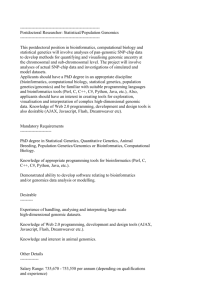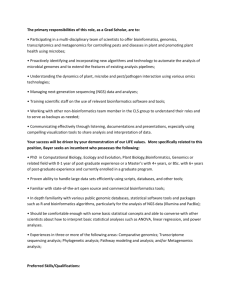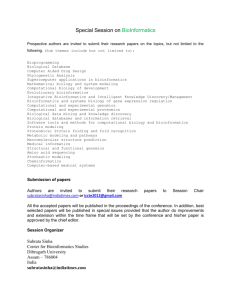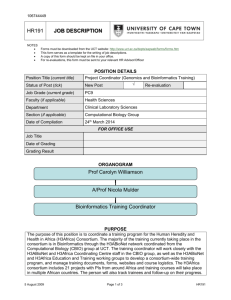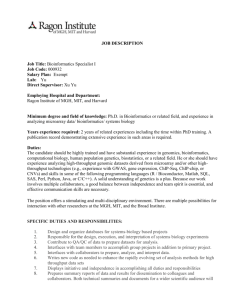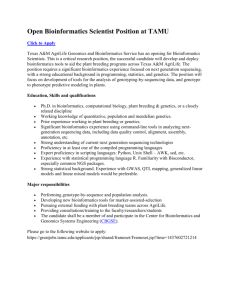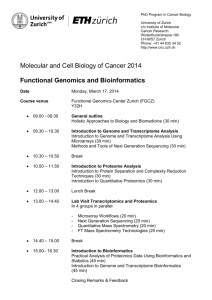Grant Template - UNC School of Information and Library Science
advertisement
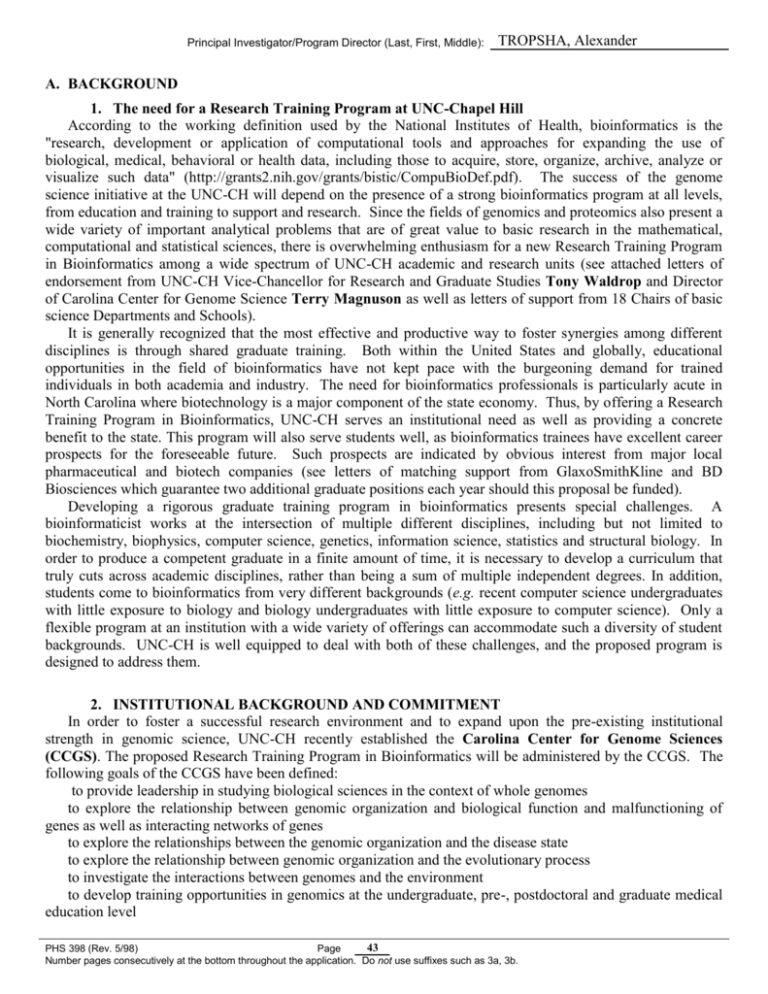
Principal Investigator/Program Director (Last, First, Middle): TROPSHA, Alexander A. BACKGROUND 1. The need for a Research Training Program at UNC-Chapel Hill According to the working definition used by the National Institutes of Health, bioinformatics is the "research, development or application of computational tools and approaches for expanding the use of biological, medical, behavioral or health data, including those to acquire, store, organize, archive, analyze or visualize such data" (http://grants2.nih.gov/grants/bistic/CompuBioDef.pdf). The success of the genome science initiative at the UNC-CH will depend on the presence of a strong bioinformatics program at all levels, from education and training to support and research. Since the fields of genomics and proteomics also present a wide variety of important analytical problems that are of great value to basic research in the mathematical, computational and statistical sciences, there is overwhelming enthusiasm for a new Research Training Program in Bioinformatics among a wide spectrum of UNC-CH academic and research units (see attached letters of endorsement from UNC-CH Vice-Chancellor for Research and Graduate Studies Tony Waldrop and Director of Carolina Center for Genome Science Terry Magnuson as well as letters of support from 18 Chairs of basic science Departments and Schools). It is generally recognized that the most effective and productive way to foster synergies among different disciplines is through shared graduate training. Both within the United States and globally, educational opportunities in the field of bioinformatics have not kept pace with the burgeoning demand for trained individuals in both academia and industry. The need for bioinformatics professionals is particularly acute in North Carolina where biotechnology is a major component of the state economy. Thus, by offering a Research Training Program in Bioinformatics, UNC-CH serves an institutional need as well as providing a concrete benefit to the state. This program will also serve students well, as bioinformatics trainees have excellent career prospects for the foreseeable future. Such prospects are indicated by obvious interest from major local pharmaceutical and biotech companies (see letters of matching support from GlaxoSmithKline and BD Biosciences which guarantee two additional graduate positions each year should this proposal be funded). Developing a rigorous graduate training program in bioinformatics presents special challenges. A bioinformaticist works at the intersection of multiple different disciplines, including but not limited to biochemistry, biophysics, computer science, genetics, information science, statistics and structural biology. In order to produce a competent graduate in a finite amount of time, it is necessary to develop a curriculum that truly cuts across academic disciplines, rather than being a sum of multiple independent degrees. In addition, students come to bioinformatics from very different backgrounds (e.g. recent computer science undergraduates with little exposure to biology and biology undergraduates with little exposure to computer science). Only a flexible program at an institution with a wide variety of offerings can accommodate such a diversity of student backgrounds. UNC-CH is well equipped to deal with both of these challenges, and the proposed program is designed to address them. 2. INSTITUTIONAL BACKGROUND AND COMMITMENT In order to foster a successful research environment and to expand upon the pre-existing institutional strength in genomic science, UNC-CH recently established the Carolina Center for Genome Sciences (CCGS). The proposed Research Training Program in Bioinformatics will be administered by the CCGS. The following goals of the CCGS have been defined: to provide leadership in studying biological sciences in the context of whole genomes to explore the relationship between genomic organization and biological function and malfunctioning of genes as well as interacting networks of genes to explore the relationships between the genomic organization and the disease state to explore the relationship between genomic organization and the evolutionary process to investigate the interactions between genomes and the environment to develop training opportunities in genomics at the undergraduate, pre-, postdoctoral and graduate medical education level 43 PHS 398 (Rev. 5/98) Page Number pages consecutively at the bottom throughout the application. Do not use suffixes such as 3a, 3b. Principal Investigator/Program Director (Last, First, Middle): TROPSHA, Alexander to support technology-based research into tools for deciphering genome function and for translation into medical practice to develop experimental, theoretical, and computational research tools to enhance genomic research to organize and maintain core facilities that provide the latest technologies essential for genetics/genomicsrelated research to promote the distribution of novel genomic technologies through technology transfer UNC-CH has committed substantial resources to establishing the CCGS as a university-wide Center (Appendix 1). The director of the CCGS reports directly to the Dean, School of Medicine/Vice Chancellor for Medical Affairs. UNC-CH has recruited Dr. Terry R. Magnuson from Case Western Reserve University to head both CCGS and the newly created Department of Genetics. The CCGS serves to focus genomics as an integrated academic discipline on campus through recognition of three umbrella programs: experimental genomics, analytical genomics, and social genomics program. The latter area is being developed to focus on policy driven research in the areas of ethical, legal and business ramifications of managing individual genomic data. The fourth component of the CCGS is education, as experimental, analytical and social genomics are important subjects for the next generation of students (from the undergraduate to the postgraduate level). B. PROGRAM PLAN 1. Program Direction The director of the Research Training Program in Bioinformatics will be Alexander Tropsha, Ph.D., Associate Professor of Medicinal Chemistry and Associate Director of the Carolina Center for Genome Sciences. Dr. Tropsha’s main expertise is in the area of biological and chemical database analysis (chemoinformatics and structural bioinfortmatics). He is particularly interested in establishing general principles of knowledge integration in the area of biomolecular informatics (cf., for instance, his recent review1). Dr. Tropsha received his M.S. degree in chemical enzymology from Moscow State University, Moscow, Russia, and Ph.D. in Biochemistry and Pharmacology from the same institution. He is currently the head of the Laboratory for Molecular Modeling at the School of Pharmacy and the Director of Graduate Studies in the Division of Medicinal Chemistry and Natural Products. Dr. Tropsha currently supervises nine Ph.D. students, two postdoctoral fellows, and a Research Assistant Professor; his research is supported by grants from NIH, NSF, and private and public companies and foundations. Dr. Tropsha will devote 10% effort to the Training Program. Dr. Tropsha brings to the directorship background and skills in biomolecular informatics and in developing practical software tools for biological research as well as his experience in directing a graduate program in the School of Pharmacy. Dr. Tropsha will be assisted in administrative activities by Ms. Geri Osborn, a recently recruited Manager of CCGS (see letter of endorsement from Dr. Magnuson). The administrative assistant will be the primary contact for prospective applicants and for administrative concerns of the trainees. Three committees will be established at UNC to assist Dr. Tropsha in the operation of the program. The Executive Committee will include high-level scientific administrators at UNC, including Deans and Senior Associate Deans of the Schools of Medicine, Public Health, Pharmacy, Information and Library Science, the College of Arts and Sciences, the Director of the Carolina Center for Genome Sciences, and the Director of the Health Science Library as well as industrial bioinformatics specialists (see letters of support from GlaxoSmithKline and Becton Dickinson). The members of the committee have scientific backgrounds in all relevant disciplines representing major pillars of bioinformatics, i.e. statistics, computing, genetics, informatics, medicine, public health, and library science. This committee will advise the Program Director on strategic planning issues and will ensure, via the administrative power of its members, that the Program is supported by an adequate body of teaching and training faculty. 1 Tropsha, A. Recent Trends in Computer-Aided Drug Discovery. Current Opinion in Drug Discovery & Development , 2000, 3, 310-313. 44 PHS 398 (Rev. 5/98) Page Number pages consecutively at the bottom throughout the application. Do not use suffixes such as 3a, 3b. Principal Investigator/Program Director (Last, First, Middle): TROPSHA, Alexander Curriculum and Progression Committee will include representatives from all participating departments. This committee is crucial for the operation of this training program. It will assume major responsibility for forming the curriculum, new course development, and monitoring students’ progress through the program. The members of this committee will ensure that the training program, which in its current form complements existing degree granting programs, integrates smoothly with the latter programs. This committee will meet in two capacities: (1) In monthly division meetings, the training program will be discussed with respect to departmental activities, and (2) monthly educational advisory meetings will cover items specific to the training program, such as curricula, requirements, student advising, etc. Members of this committee may also serve as academic advisors to bioinformatics trainees. Finally, a Program Admissions Committee will be formed each year by representatives of participating departments. All students supported by this Program, will be concurrently admitted by a participating department. The Program Admissions Committee will review all incoming applications and recommend students for funding. 2. Program Faculty When UNC completes its aggressive recruitment efforts in bioinformatics, it will have more than 20 faculty mentors in the proposed Training Program (see Appendix 1 for information on faculty recruitment). Appendix 2 summarizes the breadth of research interests of the present bioinformatics faculty. They will provide their guidance to trainees either as course directors or research advisors, or both. 3. Proposed Training a. General principles. The proposed training program is intended to provide a sound basis for professional bioinformatics work in either academia or industry and to produce research of national and global stature. All predoctoral students will be receiving Ph.D. degrees from their respective degree-granting departments with a concentration in Bioinformatics. We recognize that the present leaders in the field of bioinformatics were not trained in this field; rather, they have been trained in basic specialties relevant to informatics, i.e. data management, scientific computing, and statistical methods. Correspondingly, we emphasize basic training in these core specialties for all students in the program. Students will be required to take classes in scientific computing (COMP16) and statistics (STAT101) or have prior equivalent experience. Students coming from a background in the computational/engineering fields will need to take an introductory molecular biology class for non-biologists that will be developed by Prof. Marshall Edgell (or have equivalent prior experience). Higher level core courses will be offered (many newly developed specifically for this Program, see Appendix 3) to address the specific needs of students in the Bioinformatics Program. Required courses will include: Biological Information Storage and Retrieval (INLS 110), a new course to be taught by Prof. Brad Hemminger on databases and data mining. Computational Genetics (BIO 162), a new course to be taught by Prof. Todd Vision providing introduction to the fundamentals of computational molecular biology and sequence analysis Structural Bioinformatics (BIOC 276), taught by Prof. Alexander Tropsha, covering computational methods for protein structure analysis and prediction, Advanced Methods in Bioinformatics (BMME 231), a new course to be taught by Prof. Michael Giddings covering machine learning approaches in bioinformatics. Students will also be expected to participate in a Bioinformatics Discussion and Seminar, to be hosted each semester by a different department. This course is designed to provide an open scholarly forum for the students and to serve as a community-building exercise for the program. We will encourage attendance by Bioinformatics faculty and other interested individuals. Electives will include both existing and new specialized courses available for all trainees; examples include evolutionary biology, statistical genetics, and stochastic processes in biology. 45 PHS 398 (Rev. 5/98) Page Number pages consecutively at the bottom throughout the application. Do not use suffixes such as 3a, 3b. Principal Investigator/Program Director (Last, First, Middle): TROPSHA, Alexander We expect that most predoctoral trainees will finish their required course work within two years although those lacking many pre-requisites might require part of a third year. All students will have two research rotations in the first two semesters of the program. They will be able to choose their research mentors from all training faculty irrespective of their departmental association. We expect that by the beginning of the third semester, all predoctoral trainees will choose their primary research mentor, working in this professor’s laboratory towards their Ph.D. Importantly, the research mentor will provide the financial support for the student from this point on. It is expected that the students develop a working relationship with a secondary mentor in a complementary field, who will actively participate in oversight of the student’s training program and be on the thesis committee. For example, a student with a research mentor in Computer Science might find a secondary mentor in Biochemistry. During the entire training period (five years on average), students will participate in the Bioinformatics discussion group that will be organized and run in rotations by one of the senior faculty mentors, and we expect that all students will attend PhD defenses of their peers. Students will also be expected to present a seminar annually. In the initial years this can be a summary of current work in the field, but beginning the third year it should be a description of the student’s own research. Summer research internships with local biotech and pharmaceutical industries will provide valuable work experience for students, and such internships will be encouraged in the early years of the training program. These internships will be based on existing working relationships between senior faculty in the Bioinformatics Program and local companies. For instance, four students in Dr. Tropsha’s laboratory participated in industrial rotations at GlaxoSmithKline, BD Biosciences, Syngenta, and Pfizer last summer. Such internships have an additional benefit of fostering ties between academia and industry. b. Guidance and Monitoring The progress of trainees will be reviewed regularly by the training program faculty. Upon entry to the program, each trainee will be assigned to a member of the faculty. This faculty member will serve as the trainee’s advisor until the student has identified a thesis or dissertation committee chair and second complementary mentor. It is the responsibility of the student to meet regularly with the faculty advisor (or committee chair) and keep the advisor aware of progress toward degree requirements. As training program appointments are renewed annually, the faculty reserves the right not to renew the funding of a trainee who fails to demonstrate satisfactory progress during a 12-month appointment. The training experience of all trainees includes the Program course requirements, the Departmental PhD requirements, and the research rotation requirements. c. Degree Requirements. Predoctoral Training: All trainees enroll in a degree program within the established degree programs in participating departments. The predoctoral training typically leads to the Ph.D. degree. A minimum of 49 semester hours is required for the Ph.D. degree, including both the Departmental and the Training Program requirements. In addition to required core courses, elective and prerequisite classes are selected in consultation with the student’s advisor. Coursework in the first and second years is complemented by continuous research assistantship experiences in projects ongoing at UNC-CH. Teaching: There will be at least a semester-long teaching assistantship requirement for all trainees. The motivation for this requirement is the observation that established teaching skills are increasingly important criteria for success in academia. Trainees can fulfill this semester requirement as teaching assistants in core informatics courses or relevant courses in their home departments. d. Representative Examples of Curricula See Appendix 3 46 PHS 398 (Rev. 5/98) Page Number pages consecutively at the bottom throughout the application. Do not use suffixes such as 3a, 3b. Principal Investigator/Program Director (Last, First, Middle): TROPSHA, Alexander e. Industrial Training and Extramural Support. The development of this expanded training program has already generated substantial interest among industrial organizations throughout the Research Triangle Park. We have negotiated agreements with two major local pharmaceutical companies, GlaxoSmithKline and BD Biosciences, which committed to support one trainee each contingent upon funding for this training program from the UNC Office of the President. All trainees will be encouraged to participate in industrial rotations after their first year. An example of an agreement under development with GSK is shown in the Appendix 4. We will continue to seek additional resources from local profit and non-for-profit organizations to increase the number of trainees and be able to attract the most outstanding foreign applicants. The requested support from the Office of the President will allow us to attract future extramural funding for the program from major Federal foundations such as NIH and NSF as well as private institutions and foundations. 4. Trainee Candidates a. Recruitment Plans and Selection Criteria The availability of this training program will be indicated on the home pages of all participating departments. A sample recruitment flyer has been drafted and is attached to this proposal as Appendix 5. Both predoctoral and postdoctoral applicants apply directly to the Graduate Schools of UNC using the standard admission forms. GRE scores are required. Applicants indicate the department and area of interest on their application. Applications are forwarded by the Graduate School to the appropriate department. The Training Program faculty work closely with the department to identify which applicants may be interested in Bioinformatics. In reviewing each application, the Admissions Committee will consider the qualifications of the individual student including such criteria as grade point average, GRE scores, letters of recommendation, the statement of the student’s interests, the institution granting the undergraduate degree and professional experience. Additionally, minorities and women have priorities in the review process. Typical criteria for most departments include average undergraduate GPA greater than 3.3 and average GRE score of 1300 for admitted students. Careful consideration will be given to the candidate’s ability to successfully integrate into the Bioinformatics Program. C. RECRUITMENT OF UNDERREPRESENTED ETHNIC AND RACIAL GROUPS Using UNC minority recruitment resources, we will participate in recruitment fairs at institutions such as Gauladet, NC Central, NC A&T, Norfolk State and Prairie View. We will also develop and mail recruiting posters to a number of predominantly minority institutions and post on our home page an invitation to undergraduate students at these institutions to contact Program faculty. D. RESPONSIBLE CONDUCT OF RESEARCH Responsible conduct of research is taught formally in a course for all graduate trainees in the medical center. The course covers human subjects, scientific misconduct, responsible authorship, and other topics. Attendance in this course is required of all trainees. E. HUMAN SUBJECTS – Each research study carried out at UNC that involves the participation of human subjects is reviewed by the Committee for the Protection of the rights of Human Subjects (IRB) prior to its initiation. As mandated by NIH guidelines, al clinical research studies carried out at UNC must include appropriate representation of women and minorities. F. VERTEBRATE ANIMALS – UNC projects involving the participation of vertebrate animals must be reviewed by the Institutional Animal Care and Use Committee (IACUC) prior to its initiation. 47 PHS 398 (Rev. 5/98) Page Number pages consecutively at the bottom throughout the application. Do not use suffixes such as 3a, 3b. Principal Investigator/Program Director (Last, First, Middle): TROPSHA, Alexander APPENDIX 1. RESOURCES COMMITTED BY UNC-CHAPEL HILL TO THE CAROLINA CENTER FOR GENOME SCIENCES. RECURRING: (in 2000-2001 dollars) EPA: $1.8 million (18 faculty positions funded at $100,000 per faculty, split equally between the Center and the participating Department) -New Faculty Appointments: The Chancellor committed 18 new faculty positions for the CCGS. The positions are distributed amongst the Center’s founding academic partners: -College of Arts and Sciences: 6.5 positions -School of Dentistry: 1 position -School of Information and Library Sciences: 1 position -School of Medicine: 4.5 positions -School of Nursing: 1 position -School of Pharmacy: 1 position -School of Public Health: 3 positions SPA: $100,000 for technical support for core facilities Support for Genetics and Molecular Biology Curriculum (from SOM): $153,375 per year Medical genetics resident (from SOM): $42,000 per year Recurring overhead (future): Average grants dollars per faculty $500,000 X 18 = $ 9 million 45% overhead recovery: $225,000 X 18 = $4.05 million NON-RECURRING: Provost funds 2000-2001: $2 million, used for equipment purchases for microarray, sequencing and proteomics facility Start-up funds from Provost: $275K/position x 18 = $4.05 million (split equally between the Center and the participating department EXTERNAL: Howard Hughes Medical Institute: $2.6 million to develop mammalian genetics Federal allocation: $2.25 million ($850,000 earmarked for programmatic development and $1.4 million for one time infrastructure development to update animal facilities with new ventilated caging systems). Hooker Proteomics Gift: $25 million for proteomics ($5 million per year for five years. To be used for faculty recruitment, equipment purchases and program development) Whitaker Foundation Award: $ 1 million to create a graduate training tract entitled “Functional Genomics for the Biomedical Engineers” 48 PHS 398 (Rev. 5/98) Page Number pages consecutively at the bottom throughout the application. Do not use suffixes such as 3a, 3b. Principal Investigator/Program Director (Last, First, Middle): TROPSHA, Alexander NIH Genetics Training Grant: $210,392 current year direct costs. This award includes stipend support for 8 predoctoral students per year. SPACE. Administrative space will be housed in the new Human Biomolecular Research Building. Participating academic departments will provide research laboratories for faculty from their current allotted space. The seven academic partners will be required to assist the CCGS by providing funds for upgrading existing physical space to meet the changing scientific needs and requirements associated with genomics research. Although some of the computational needs will be housed in the new Bioinformatics building, it is also understood that experimental and computation projects are inherently linked and must interact. The design of adjacent “wet” and “dry” space such as that in the new Human Biomolecular Research Building achieves this goal. 49 PHS 398 (Rev. 5/98) Page Number pages consecutively at the bottom throughout the application. Do not use suffixes such as 3a, 3b. Principal Investigator/Program Director (Last, First, Middle): TROPSHA, Alexander FACULTY RECRUITMENT UNC is aggressively recruiting leading specialists in experimental and computational genomics and proteomics. The following advertisement appeared in one of the September 2001 issues of the Science magazine. Genomics at UNC-Chapel Hill The Carolina Center for Genome Sciences Providing context, meaning and utility to the immense catalogs of sequence data is a challenge orders-ofmagnitude more complex than previously faced. Yet, with these data, the potential for producing exciting bench-tobedside-to-population based paradigms is limitless. To fuel discovery and to capitalize on these extraordinary opportunities during the post-genome functional biology era, the University of North Carolina at Chapel Hill has established the newly integrated, multi-disciplinary Carolina Center for Genome Sciences. Through the efforts of the Center and its member academic departments, 16 outstanding faculty were recruited last year: Shawn Ahmed: The Department of Genetics, School of Medicine and the Department of Biology. Research Area: Telomere replication, DNA damage, and germline immortality Dennis Cheek: School of Nursing Research Area: Cardiovascular Frank Conlon: The Department of Genetics, School of Medicine Research Area: Heart development, Mesodermal patterning, T box genes Greg Copenhaver: Department of Biology, College of Arts and Sciences Research Area: Centromere structure, tetrad analysis, Arabiposis Brad Hemminger: The School of Information and Library Sciences Research area: Medical and bio-informatics, Computer-human interfaces, Computer-supported collaborative work Information visualization Jason Leib: The Department of Biology, College of Arts and Sciences Research Area: Transcriptional networking, microarray analyses Rihe Liu: The Division of Medicinal Chemistry, School of Pharmacy Research Area: RNA: protein fusion arrays Fernando Pardo-Manuel: Department of Genetics, School of Medicine Research Area: Female meiosos, Chromosome segregation, Non-mendelian genetics Charles Perou: Department of Genetics, School of Medicine Research Area: Breast cancer, Genomics, Microarrays, Tumor classification, Drug resistance Larysa Pevny: Department of Genetics, School of Medicine Research Area: Neural induction, Neurogenesis, SOX proteins David Threadgill: Department of Genetics, School of Medicine Research Area: Disease susceptibility, Mutagenesis, Colon cancer, Genetic engineering, Microarrays Debbie Threadgill: Department of Genetics, School of Medicine Research Area: C. jejuni, Glycobiology, Genetics of blycosylation, Peripheral neuropathy, Host-pathogen / symbiont interations Marcia Van Riper: School of Nursing Research Area: Social genomics Todd Vision: Department of Biology, College of Arts and Sciences Research Area: Computational genetics, genome evolution and the architecture of complex traits Fred Wright: Department of Biostatistics, School of Public Health Research Area: Statistical Genetics Fei Zou: Department of Biostatistics, School of Public Health Research Area: Statistical Genetics The Center continues to expand its faculty recruitment in genomics in association with The College of Arts and Sciences, The School of Medicine and The School of Public Health. The following positions are available: Bioinformatics: preference will be given to specialists in mathematical, statistical, and computer sciences. We are looking for scientists who bring modern tools of theory, modeling and computation to bear on critical aspects of biological information. We encourage applicants working at any level of biological organization, from biochemistry and genomics to systematics and evolution; and using any appropriate quantitative approach, including combinatorial analysis, data mining, and stochastic and geometric modeling. Depending on the topic, the primary appointment for this position will be in the Departments of Computer Science, Mathematics, Operations Research or Statistics and/or an appropriate Department in the School of Medicine. 50 PHS 398 (Rev. 5/98) Page Number pages consecutively at the bottom throughout the application. Do not use suffixes such as 3a, 3b. Principal Investigator/Program Director (Last, First, Middle): TROPSHA, Alexander Biomacromolecules: preference will be given to those candidates that possess a broad base research focus in bioinformatics and to those that desire an appointment in an excellent Chemistry department with active research programs that include combinatorial chemistry, capillary electrophoresis, structural (X-ray, AFM, NMR) studies of biomacromolecules, neurochemistry, realistic molecular dynamics of biomacromolecules, theory of enzyme reactivity or RNA/DNA catalysis. Biological Chemistry: Priority will be given to candidates with interests, broadly defined, in the areas of proteomics, gene expression arrays, structural biology and the development and application of new chemical methods to the investigation of problems in genomics. Primary appointment will be in the Division of Biological Chemistry of the Department of Chemistry. Applications are strongly encouraged from candidates whose expertise will bridge the interface between chemistry and biology. Behavioral Phenotyping: Preference will be given to candidates with expertise in mouse behavioral phenotyping. We are particularly interested in individuals with active research programs in neuroscience that focus on gene-behavior interactions. The appointment for this position will be in the Department of Psychology, and the successful candidate will also assume responsibility for the directorship of the Mouse Behavior Phenotyping Core of the interdisciplinary Neurodevelopmental Disabilities Research Center. Cellular Imaging: Priority will be given to applicants whose research involves the use and development of sophisticated light microscopy techniques to study how protein complexes work as molecular machines in living cells and developing organisms. Primary appointment will be in the Department of Biology. Human Genetics: We are specifically targeting candidates interested in common diseases, cancer genetics, structure/function and genomic organization. Physician scientists are encouraged to apply. UNC-Chapel Hill has exceptionally strong programs in medical genetics, mouse genetics, and invertebrate genetics. The primary academic appointment will be in the Department of Genetics, with the possibility of joint appointments in relevant Clinical Departments. Nutrition: We are seeking an individual with a doctorate in an appropriately related discipline and a track record in an area of research focused on the use of genomics to study questions pertinent to the field of nutrition (e.g., genomics and metabolism, genomics and nutrition epidemiology) to fill a tenure-track or tenured appointment in the Dept. of Nutrition beginning on or after July 1, 2002. Rank will be determined by the applicant's qualifications. Statistical Genetics: We are seeking candidates with a strong background in both statistics and genetics. We are interested in persons who can develop and evaluate new statistical techniques, as well as assist in the analysis complex genetics data bases. The primary appointment will be in the Department of Biostatistics with the possibility of a joint appointment in the Department of Genetics or the reverse if appropriate. Successful candidates will be expected to contribute to undergraduate, graduate or postgraduate teaching and to establish an externally funded research program. Review of applications will begin on October 15, 2001. Send curriculum vitae, a description of research interests, and four letters of reference to: Dr. Terry Magnuson, Director of The Carolina Center for Genome Sciences, CB 7000, Room 43 MacNider, University of North Carolina, Chapel Hill, NC 27599-7000. Please indicate the position of interest. UNC is an equal opportunity/ADA employer. Women and minorities are encouraged to apply. 51 PHS 398 (Rev. 5/98) Page Number pages consecutively at the bottom throughout the application. Do not use suffixes such as 3a, 3b. Principal Investigator/Program Director (Last, First, Middle): TROPSHA, Alexander APPENDIX 2. PARTICIPATING FACULTY MENTORS. Max Berkowitz Marshall Edgell Michael Giddings Brad Hemminger Jan Hermans Clyde Hutchison Andrew Nobel Lars Nyland Chemistry We are interested in the elucidation of the intricate nature of processes occurring in condensed phases. Thus we study the structure and dynamics of water next to metallic surfaces, structural and dynamical properties of surfactant monolayers on the water/air and on water/oil interfaces and structural and dynamical properties of phospholipid membranes. Our research is performed using molecular dynamics computer simulation technique Microbiology & Dr. Edgell is exploring the use of the mathematical formalism of Immunology regression analysis to enhance the use of mutagenesis to test hypotheses concerning protein folding and stability. This research is bringing high throughput biophysics and computer modeling to bear on hypothesis testing. The research is a collaboration drawing on expertise from molecular genetics, computer modeling, biophysics and statistics. Microbiology/ Development of bioinformatics methods within the purview of Immunology and proteomics (the comprehensive study of proteins expressed in a cell). Biomedical Particular focus upon methods by which multiple isoforms of Engineering proteins are expressed by single genes. School of Development of bioinformatics methods within the purview of Information and proteomics (the comprehensive study of proteins expressed in a cell). Library Science Particular focus upon methods by which multiple isoforms of proteins are expressed by single genes. Biochemistry and Methods and techniques for molecular dynamics simulations of Biophysics proteins. Solvation models. Computational structural biology. Microbiology & Research interests: the minimal cellular genome, structural genomics, Immunology mutational analysis of protein stability and dimerization, transposable elements and the evolution of the mammalian genome. This laboratory has carried out investigations on biological systems ranging from bacteriophage to mice. The unifying theme has been a continuing search for improved methods to learn about gene function from DNA sequence information. Current projects fall under three main topics: Genomics, the L1 retroposon in mammals and directed Mutagenesis. My research interests that overlap the training grant are multivariate Statistics clustering and classification, pattern recognition, and complexity regularization. To date my work has focussed on the asymptotic properties of greedy growing algorithms and histogram estimation schemes using data dependent partitions. Computer Science Self-Scheduling N-body Algorithms—a project to explore a family of algorithms that rapidly compute N-body interactions. Efficient, complex parallel algorithms for N-body calculations and constructive solid geometry have been developed as part of the project. Computational Structural Biology Research Resource-- research resource providing biochemists, biophysicists and chemists with high-performance software and hardware. My role is to design and implement parallel methods of computation, for applications such as molecular dynamics simulators. I also evaluate and recommend computing hardware. 52 PHS 398 (Rev. 5/98) Page Number pages consecutively at the bottom throughout the application. Do not use suffixes such as 3a, 3b. Principal Investigator/Program Director (Last, First, Middle): Lee Pedersen Chemistry Jan Prins Computer Science Scott Provan Operations Research Jack Snoeyink Computer Science Alexander Tropsha School of Pharmacy Todd Vision Biology Fred Wright Biostatistics TROPSHA, Alexander We attempt to accurately develop all-atom models for proteins for which we have partial structural data. We work also to develop quantum mechanical models for enzymatic active sites. We are interested in coagulation proteins (serine proteases), HIV-1 RT, P450's, p21-H-ras and sulfotransferases. Interests: High-level programming languages; formal techniques in program development; parallel algorithms and parallel computation; compilation of programs for parallel execution. Projects: Software and development for the DeltaSphere 3D Scene Digitizer with Lars Nyland at 3rdTech, Inc. Irregular Parallel Algorithms; algorithmic, language, compilation, and hardware techniques for high performance execution of unstructured Parallel Computing Resource for Structural Biology: parallel algorithms and implementations for Molecular Dynamics simulations Computational methods in networks and network reliability, geometric and discrete optimization and polyhedral combinatorics. Current problem areas: (1) designing networks with specified performance capabilities such as sufficient throughput volume, small communications delay, specified connectivity, or enclosure/separation properties, (2) determining shortest paths in stochastic networks with limited information about network congestions, (3) characterizing and predicting geometric structure for protein folding, (4) ongoing development of IDEAS, the Instructional Database for Educational and Academic Software, a teaching software platform. Discrete and computational geometry; Analysis of algorithms; Geographic Information Systems (GIS); Theory of computer science. Applications of Computational geometry to protein structure analysis and prediction. The major area of our research is Biomolecular Informatics, which implies understanding relationships between structures (organic or macromolecular) and their properties (activity or function). We have developed several methodologies and software tools for Computer Assisted Drug Design (http://mmlin1.pha.unc.edu/~jin/QSAR.) We have developed a new approach to protein 3D structure analysis and prediction based on the principles of statistical geometry (Delaunay tessellation). This approach affords determination of key structural and sequence motifs responsible for protein function. Some of our methodologies have been implemented on the Protein Structure Workbench at http://mmlsun4.pha.unc.edu/3dworkbench.html. Genome duplication and chromosomal rearrangement, map-based analysis of complex phenotypes Genetic linkage mapping, association studies, microarray analysis and genomics. Interests also include robust methods for quantitative trait mapping in humans and model organisms, and in haplotype reconstruction approaches that do not require strong assumptions of population history. Recent work includes draft annotations of the human genome and methods for improving the estimation of gene expression using oligonucleotide arrays. 53 PHS 398 (Rev. 5/98) Page Number pages consecutively at the bottom throughout the application. Do not use suffixes such as 3a, 3b. Principal Investigator/Program Director (Last, First, Middle): Fei Zou Biostatistics TROPSHA, Alexander Statistical genetics, Empirical likelihood, Bioinformatics 54 PHS 398 (Rev. 5/98) Page Number pages consecutively at the bottom throughout the application. Do not use suffixes such as 3a, 3b. Principal Investigator/Program Director (Last, First, Middle): TROPSHA, Alexander APPENDIX 3. TYPICAL PROGRAMS OF STUDY The following is a typical academic program leading to the Ph.D. in Biochemistry with concentration in Bio-Medical Informatics for a student with a biochemical background. This program assumes that the student has knowledge of advanced calculus and a strong background in biochemistry and molecular biology. Elective experiences will be selected in consultation with the student's advisor. Course credit hours appear after courses. Courses specific to this core appear in bold. First Year FALL COMP16 STAT 101 BIOL 162 Intro to Scientific Programming 3 Statistical Methods I Computational Genetics 3 3 3 3 3 1 BIOC 205 BIOC 104, or BIOC 110/111, or BIOC 117/118, or BIOC 134, or BIOC 150-157 1-3 Research rotation Research rotation Summer BIOC 212 Second Year FALL BMME 231 PHCO 211I BIOC 1xx Scientific writing Industrial Rotation Advanced topics in Bioinformatics Discovery Biology & Pharmacogenomics Experimental Genomics and Proteomics SPRING INLS 110 Biological Information Storage and Retrieval 3 Seminar Enzyme properties Adv. Mol. Biol. Cell structure Studies in str. mol. biol; Phys. Biochem. modules 2 3 3 3 3 1 1-3 2 1 3 SPRING BIOC276 Structural Bioinformatics 2 1 3 2 Dissertation research 1-3 Research rotation Later Years – Dissertation research as directed by individual advisors. 55 PHS 398 (Rev. 5/98) Page Number pages consecutively at the bottom throughout the application. Do not use suffixes such as 3a, 3b. Principal Investigator/Program Director (Last, First, Middle): TROPSHA, Alexander The following is a typical academic program leading to the Ph.D. in Computer Science with concentration in Bioinformatics for a student with a computational background. This program assumes that the student has some undergraduate biology and/or chemistry, and a strong background in computer science, which would include probability/statistics and advanced calculus. Elective experiences will be selected in consultation with the student's advisor to satisfy distribution requirements in Computer Science (12 hours: 3 theory, 3 systems, 3 applications) and to prepare for comprehensive and qualifying exams. Course credit hours appear after courses. Courses specific to this core appear in bold. First Year FALL BIOL 162 COMP 202 or COMP 204 or COMP 235 MICR1xx Computational Genetics Analysis of Algorithms Software Design Images, Graphics&Vision Introductory Molecular Biology Lab Research rotation SPRING MATH 192 (COMP 205) INLS 110 3 COMP 29069 or COMP 203 or COMP 254 COMP 291 Exam 2 Scientific Computation 3 Biological Information Storage and Retrieval 3 Scientific visualization Parallel and Distrib. C. Image Processing and Analysis Prof. Writing in Comp Sci. Comprehensive, Integrative Paper 3 3 3 Structural Bioinformatics elective Scientific visualization Parallel and Distrib. C. Image Processing and Analysis Physically Based Modeling 3 3 Summer Industrial Rotation Second Year FALL BMME 231 COMP 202 or COMP 204 or COMP 235 or COMP 29079 Advanced topics in Bioinformatics Analysis of Algorithms Software Design Images, Graphics&Vision Computational Geometry 1 3 3 3 3 3 SPRING MEDC276 COMP 29069 or COMP 203 or COMP 254 or COMP 259 Exam Qualifying Oral Lab Research rotation Later Years – Dissertation research as directed by individual advisors. 56 PHS 398 (Rev. 5/98) Page Number pages consecutively at the bottom throughout the application. Do not use suffixes such as 3a, 3b. 3 3 3 3 Principal Investigator/Program Director (Last, First, Middle): TROPSHA, Alexander APPENDIX 4. TYPICAL INDUSTRIAL TRAINEESHIP AGREEMENT. University of North Carolina at Chapel Hill _________________Graduate Program Graduate Industrial Traineeship (GIT) in cooperation with Glaxo Wellcome Inc. Research Triangle Park, NC Faculty Advisor: ______________ Total Funding: $ ______________ Period of Support: _________________ One graduate student from the Graduate Program in ____________will be placed as a graduate industrial trainee with Glaxo Wellcome, Inc., Research Triangle Park, NC. Under the supervision of Dr. ____________ of Glaxo Welcome, Inc., and the faculty advisor, the trainee will engage in consulting, collaboration, research and training related to the ___________ program at the company. The trainee will work ___hours per week for the period ______________through _________. The trainee selected for this position is __________________. _________________________ Faculty Advisor __________ Date _________________________ UNC Department Head __________ Date _________________________ University of North Carolina __________ Date _________________________ GlaxoWellcome, Inc. __________ Date 57 PHS 398 (Rev. 5/98) Page Number pages consecutively at the bottom throughout the application. Do not use suffixes such as 3a, 3b.

